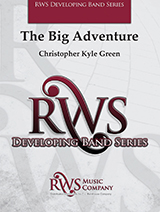Results
-
 £119.99
£119.99A Knight's Tale - Wilco Moerman
In A Knight's Tale, Wilco Moerman takes the listener back to the Middle Ages, when castles, knights' tournaments and charming ladies were the order of the day. It describes scenes of the middle ages as one would expect from fairytales or movies featuring this period - with a duel between knights, hidden romances and a battlefield. The composer makes sure that all groups are well represented and includes lots of brass and percussion as well as chanting melodies and spectacular virtuoso segments which make this piece a perfect contest or concert opportunity.
Estimated dispatch 7-14 working days
-
 £103.00
£103.00Nightflight - James Swearingen
While traveling by air, the composer was able to view three distinctive scenes of the city of Miami, Florida that are all musically portrayed in this significant and creative work. High energy, driving tempos, memorable themes, Latin percussion and contemporary harmonies all combine to create a remarkable and exciting three movement suite. This wonderful composition is destined to become a standard in the repertoire of wind band literature. A superb choice for concert or festival!I. Street CarnivalII. A Heavenly ViewIII. Fireworks Galore!
Estimated dispatch 7-14 working days
-
 £121.00
£121.00Cityscapes - Rob Romeyn
Rob Romeyn's "Cityscapes" is a brilliantly programmatic and celebratory concert opener for mature ensembles. Audiences will be mesmerized by the sparkling opening measures depicting the hustle and bustle of a large city. Our journey continues with a sensitive and expressive section depicting a sunset over downtown, then leads to a section of building intensity and power, creating an incredible climax. From here, the intensity subsides, building imagery of the beautiful scenes of what a large city has to offer. The piece develops further, eliciting an ending of immense emotion and power as our journey concludes. A part for optional piano is included. A valuable addition to the repertoire for more experienced ensembles, "Cityscapes" is sure to impress!This work is not yet in print. Please check back later to view the conductor score and for purchasing information. In the meantime, please enjoy this recording performed by The Washington Winds, conducted by Edward S. Petersen.
Estimated dispatch 7-14 working days
-
 £75.24
£75.24Nightflight
While traveling by air, the composer was able to view three distinctive scenes of the city of Miami, Florida that are all musically portrayed in this significant and creative work. High energy, driving tempos, memorable themes, Latin percussion and contemporary harmonies all combine to create a remarkable and exciting three movement suite. This wonderful composition is destined to become a standard in the repertoire of wind band literature. A superb choice for concert or festival!
Estimated dispatch 7-14 working days
-
 £72.00
£72.00Snow Swirls
Snow Swirls is a depiction of the many scenes of nature that we experience during the winter months. The swirls begin gently at the outset but before we know it, our world is turning white!
Estimated dispatch 12-14 working days
-
£58.50
The Big Adventure - Green
The Big Adventure explores scenes of an uncharted island woodland full of quirky plants and animals. Written for the young band, the percussion section will be exposed to accessory instruments such as the guiro, vibraslap, cabasa, wood block and more. The piece will make a great addition to any concert as the audience joins you and the ensemble on your island excursion.
Estimated dispatch 7-14 working days
-
 £82.95
£82.95Sentinel - Robert Sheldon
Sentinelis a musical portrait of a lighthouse that conjures scenes of calm waters at sunrise, recreational boaters, beachgoers, and the powerful storms that come ashore. Opening fanfares give way to a carefree melody before an aggressive statement in low voices announces the storm's arrival. A dynamic work by Robert Sheldon.
Estimated dispatch 7-14 working days
-
 £60.00
£60.00The Big Adventure (Concert Band - Score and Parts) - Green, Christopher Kyle
The Big Adventure explores scenes of an uncharted island woodland full of quirky plants and animals. Written for the young band, the percussion section will be exposed to accessory instruments such as the guiro, vibraslap, cabasa, wood block and more. The piece will make a great addition to any concert as the audience joins you and the ensemble on your island excursion. Duration: 2.30
Estimated dispatch 7-14 working days
-
 £53.95
£53.95Fantastic Adventure - Todd Stalter
Fantastic Adventure, by Todd Stalter, has many surprises within its short duration for our confident hero, including scenes of mystery, danger, a waltz in a beautiful ballroom, and a challenging encounter to conquer. How does it end? You decide! (1:50)
Estimated dispatch 7-14 working days
-
 £89.99
£89.99River Rendezvous - Michael Sweeney
River Rendezvous conceived as a work for multi-level band festivals, however it also serves as a dynamic stand-alone composition for grade 3 bands. Representing moods and scenes of the Fox River in southern Wisconsin, the twocontrasting movements may be performed separately or together. The primary themes in each movement are simple enough for beginning players, and are then embellished and developed in the more advanced levels. Sure to be an excitingextravaganza for parents and students alike! Dur: c. 6:00
Estimated dispatch 7-14 working days
